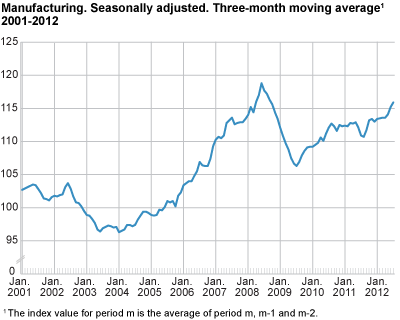Content
Published:
This is an archived release.
Upswing in manufacturing
Production in manufacturing increased by 2.0 per cent from May to July 2012 compared with the previous three-month period, according to seasonally-adjusted figures.
Industries like machinery and equipment, and ships, boats and oil platforms had significant production growth in this period. This growth can be related to a strong increase in new orders for these industries (see statistics for new orders) , due to a very high level of investments within the Norwegian petroleum sector (see investments oil and gas activity ). Furthermore, production in food products also went up in this period, due to a solid increase in fish and fish products. Strong demand for farmed salmon is the key factor behind this growth, and the harvest of salmon was thus clearly larger in July 2012 than in July 2011. On the other hand, industries such as wood and wood products and basic chemicals had a downturn in production from May to July 2012 compared with the previous three-month period.
From July 2011 to July 2012
Manufacturing saw growth of 7.6 per cent from July 2011 to July 2012 according to working-day adjusted figures. Industries like machinery and equipment, and ships, boats and oil platforms had strong production growth, while basic chemicals and paper and paper products had a substantial drop in production. In addition, food products also saw an increase in production from July 2011 to July 2012.
From June to July 2012
The production in Norwegian manufacturing went up by 0.3 per cent from June to July 2012, according to seasonally-adjusted figures. Food products, machinery and equipment together with ships, boats and oil platforms had a growth in production, while non-ferrous metals had a decrease in production.
Norway and the euro area
There was a 4.3 per cent increase in Norwegian manufacturing output from June 2011 to June 2012, according to working-day adjusted figures. Industrial production in the euro area decreased by 2.4 per cent in the same period, according to figures published by Eurostat .
| Adjusted for working-days 1 | Seasonally adjusted | ||||||||||||||||||||||||||||||||||||||||||||||||||||||||||||||||||||||||||||||
|---|---|---|---|---|---|---|---|---|---|---|---|---|---|---|---|---|---|---|---|---|---|---|---|---|---|---|---|---|---|---|---|---|---|---|---|---|---|---|---|---|---|---|---|---|---|---|---|---|---|---|---|---|---|---|---|---|---|---|---|---|---|---|---|---|---|---|---|---|---|---|---|---|---|---|---|---|---|---|---|
| July 2011- July 2012 | January 2011-July 2011- January 2012-July 2012 | June 2012- July 2012 | February 2012-April 2012- May 2012-July 2012 | ||||||||||||||||||||||||||||||||||||||||||||||||||||||||||||||||||||||||||||
| The overall index | 2.6 | 5.6 | -4.5 | 1.9 | |||||||||||||||||||||||||||||||||||||||||||||||||||||||||||||||||||||||||||
| Oil and Gas Extraction | 1.3 | 3.2 | -6.5 | 2.3 | |||||||||||||||||||||||||||||||||||||||||||||||||||||||||||||||||||||||||||
| Manufacturing | 7.6 | 2.2 | 0.3 | 2.0 | |||||||||||||||||||||||||||||||||||||||||||||||||||||||||||||||||||||||||||
| Electricity, Gas and Steam Supply | -1.5 | 25.5 | -8.4 | 2.6 | |||||||||||||||||||||||||||||||||||||||||||||||||||||||||||||||||||||||||||
| Main industrial groupings | |||||||||||||||||||||||||||||||||||||||||||||||||||||||||||||||||||||||||||||||
| Intermediate goods | 1.9 | 2.3 | 0.6 | 0.1 | |||||||||||||||||||||||||||||||||||||||||||||||||||||||||||||||||||||||||||
| Capital goods | 14.3 | 9.8 | -0.1 | 4.1 | |||||||||||||||||||||||||||||||||||||||||||||||||||||||||||||||||||||||||||
| Consumer goods | 9.2 | -0.4 | 0.1 | 3.6 | |||||||||||||||||||||||||||||||||||||||||||||||||||||||||||||||||||||||||||
| Energy goods | 0.3 | 4.7 | -5.9 | 0.0 | |||||||||||||||||||||||||||||||||||||||||||||||||||||||||||||||||||||||||||
| 1 | Adjusted for working-days and for public holidays in Norway. |
Interpretation of seasonally-adjusted figuresIn order to facilitate the interpretation of the short-term development, the index of production publishes three-month moving averages of the seasonally-adjusted figures. We normally compare the latest non-overlapping three-month periods, for instance May to July 2012 compared with February 2012 to April 2012. Seasonally-adjusted monthly changes must be interpreted with caution. |
Number of hours workedThe numbers of hours worked by contracted workers is included in the calculation of the Index of production for the first time from January 2012 onwards. These numbers are collected from January 2011. The inclusion of numbers of hours worked by contracted workers may lead to somewhat larger short-term fluctuations for some industries. At the same time, the development will be more accurately measured for industries where hours worked are used as an indicator. Industries like ships, boats and oil platforms and repair and installation of machinery typically use contracted workers in periods with high activity. |
New projectsNew projects in industries with hours worked as an indicator are intercepted at start-up, as long as the project is carried out by establishments covered by the sample. It is the total number of hours carried out in the survey period that is reported, regardless of which project the hours are spent on. |
Tables
Contact
-
Production and turnover
E-mail: prodoms@ssb.no

